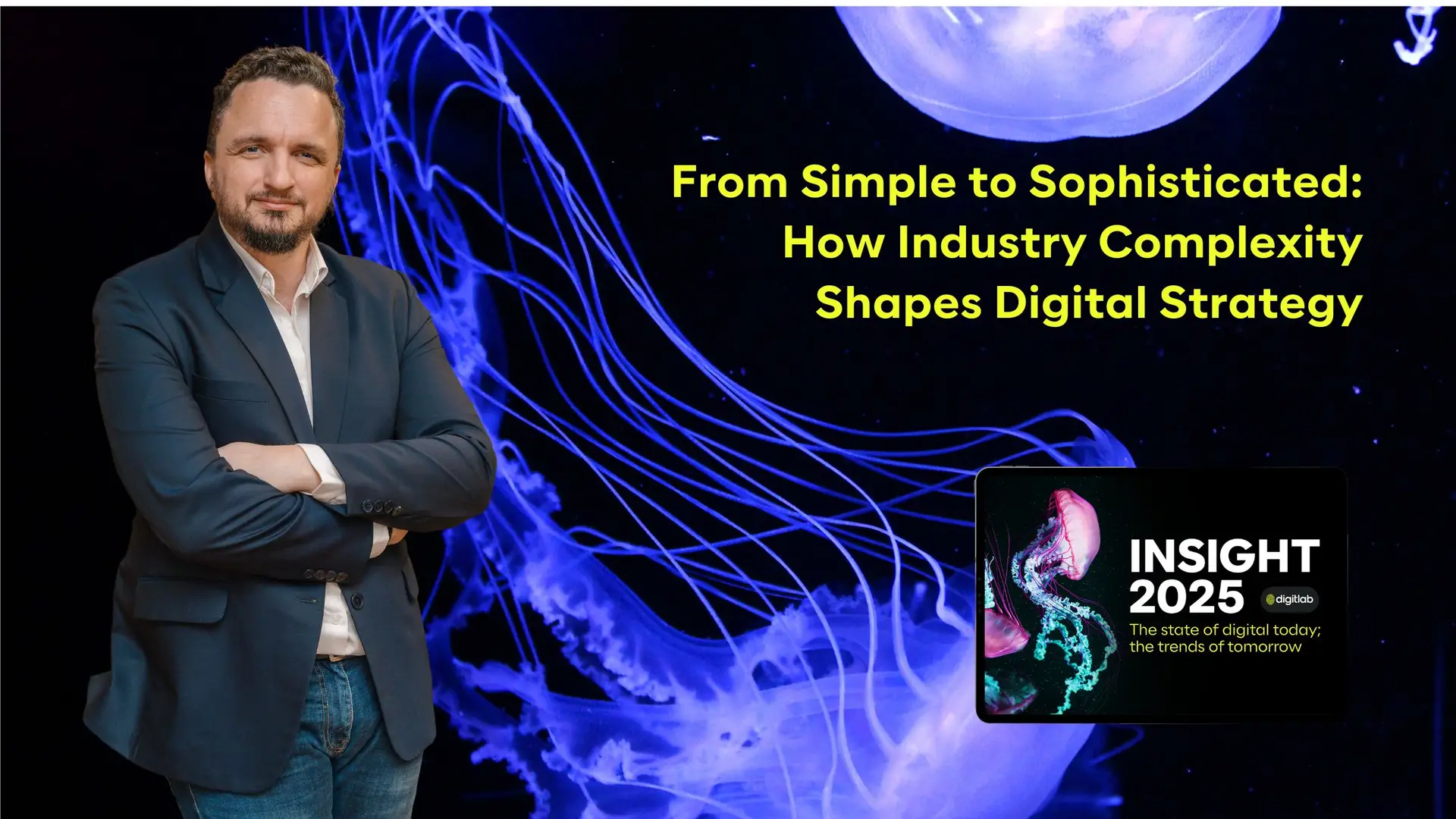At Digitlab, we take pride in exploring the evolving digital landscape, and there’s no one better equipped to guide us through it than our CEO, Mike Saunders. In his latest article, From Simple to Sophisticated: How Industry Complexity Shapes Digital Strategy, Mike unpacks the critical insights from our Insight 2025: State of Digital Survey.
In today’s digital marketplace, where customers expect seamless interactions across online and offline spaces, businesses face a pivotal challenge: connecting with and retaining customers without overextending resources or diluting their brand.
This challenge lies at the heart of our deep reflection on the findings from this year’s Insight 2025: State of Digital Survey, which reveals a fundamental insight: the complexity of customer engagement channels directly shapes the digital strategy that will drive success.
The survey results tell a straightforward story—industries with multiple customer channels and diverse customer types require sophisticated omnichannel strategies. At the same time, those with fewer touchpoints benefit from a more streamlined, focused approach. Companies that align their digital strategy with their unique complexity level maximise impact, reduce waste, and improve customer satisfaction. In contrast, misaligned strategies often lead to inflated costs, operational strain, and a fractured customer experience.
Here’s how companies across different complexity stages can apply these insights to craft digital strategies that deliver real value, keep customers engaged, and set a clear path for growth.
High Complexity: Why It’s Essential for Multi-Channel Engagement
Why It Matters
The stakes are high for high-complexity industries. A telecom company or a retailer with numerous customer touchpoints cannot afford to let any channel feel disconnected. Customers today expect that the in-store experience matches the one online, and a gap in this experience can lead to mistrust, frustration, and customer churn.
Story: Imagine a national retailer with a fragmented approach to online and in-store channels. In that case, customers might buy a product online only to find it unavailable for pickup in their local store—a disappointing experience that might lead them to a competitor. However, an Omnichannel Customer Experience Framework allows the retailer to align inventory, streamline customer support, and personalise promotions across all touchpoints. This consistency is what keeps customers returning.
What’s at Stake
Failing to integrate channels leads to siloed operations for high-complexity companies, which means higher costs, duplicated efforts, and a disjointed customer experience. When brands prioritise omnichannel integration, they can serve customers effectively, personalise at scale, and build the brand loyalty that drives long-term growth.
Moderate Complexity: The Balance of Primary and Secondary Channels
Why It Matters
There’s a critical balance to maintain in industries like finance or education. These sectors must prioritise primary channels, like digital banking for a financial services provider, while strategically enhancing secondary channels to meet specific needs. Over-investing in secondary channels could divert resources away from essential services, while under-investing might cause them to miss out on valuable customer touchpoints.
Story: Consider a financial services firm primarily serving retail customers through online banking. By investing wisely in personalised, high-touch services for their business clients (B2B), they gain a foothold in corporate financial services without disrupting their primary consumer-focused business. This balanced approach enables growth without losing the core audience’s trust.
What’s at Stake
Moderate-complexity businesses that don’t balance channels risk operational inefficiencies and missed opportunities. Strategic use of a Hybrid Digital Strategy Framework helps them maximise the impact of their primary channels while expanding into secondary channels that offer additional growth and customer engagement.
Low Complexity: Maximising Focus for High-Impact Engagement
Why It Matters
Low-complexity industries—automotive, health & fitness, or real estate—often engage customers through limited, focused channels. This simplicity can be a strength. By concentrating resources on a single channel or a few high-impact touchpoints, these companies can offer more profound, consistent experiences that build loyalty and keep operating costs low.
Story: A fitness brand that only uses its app and gym locations to engage customers can invest deeply in those experiences. It can deliver seamless digital workouts, personalised app updates, and in-gym services that strengthen customer connections. Expanding into additional channels could dilute the experience, wasting resources and confusing customers.
What’s at Stake
Companies that try to expand their limited engagement models unnecessarily often waste resources and risk diminishing the quality of their core experience. A Focused Customer Value Framework allows these businesses to stay efficient and deliver consistent, high-quality interactions, ensuring customer interaction counts.
Single-Channel or Specialised Models: Streamlining for Precision and Reliability
Why It Matters
Industries operating with a single channel, like government services or agriculture, don’t need elaborate, multi-channel systems. Their customers rely on simplicity and reliability. By maintaining streamlined, focused engagement, they can keep interactions user-friendly and cost-effective, delivering exactly what’s needed without unnecessary friction.
Story: A government service portal that prioritises usability over flashy features allows citizens to access permits, renew licenses, and pay fees quickly. If this portal introduced unnecessary layers or features, it might complicate the user journey, making it harder for citizens to accomplish simple tasks.
What’s at Stake
For single-channel industries, simplicity is their strength. They can deliver highly reliable, specialised services when they avoid extraneous complexity. A Simplified Digital Engagement Framework allows them to focus on optimising these interactions, resulting in a smoother, more satisfying experience for users.
Strategic Takeaways: Why Aligning Complexity with Strategy Matters
Misaligning digital strategy with complexity is inefficient and costly. High-complexity businesses that fail to implement an omnichannel approach risk customer churn and operational strain, while low-complexity companies that spread themselves thin lose out on their core strengths.
Tailoring digital strategy to complexity allows businesses to capitalise on their unique strengths, delivering better customer experiences and more thoughtful resource use.
- High Complexity: Adopt an omnichannel framework to unify diverse touchpoints, reduce silos, and improve the customer journey.
- Moderate Complexity: Balance primary and secondary channels for optimal growth, using a Hybrid Framework to ensure focus without missing new opportunities.
- Low Complexity: Leverage the Focused Customer Value Framework to maximise impact on a single channel, delivering quality experiences that build loyalty.
- Single-Channel Models: Use a Simplified Digital Engagement Framework to ensure reliable, user-friendly interactions that meet specific customer needs.
Ultimately, aligning strategy with complexity empowers companies to play to their strengths.
In a digital world where customer expectations are high and resources are finite, businesses that understand and adapt to their complexity stage are the ones that will thrive. For them, the journey from simple to sophisticated isn’t about adding more—it’s about finding what works and focusing on making it exceptional.
You can read more from our other contributors and download the full report here: https://digitlab.co.za/digital-trends-report/






